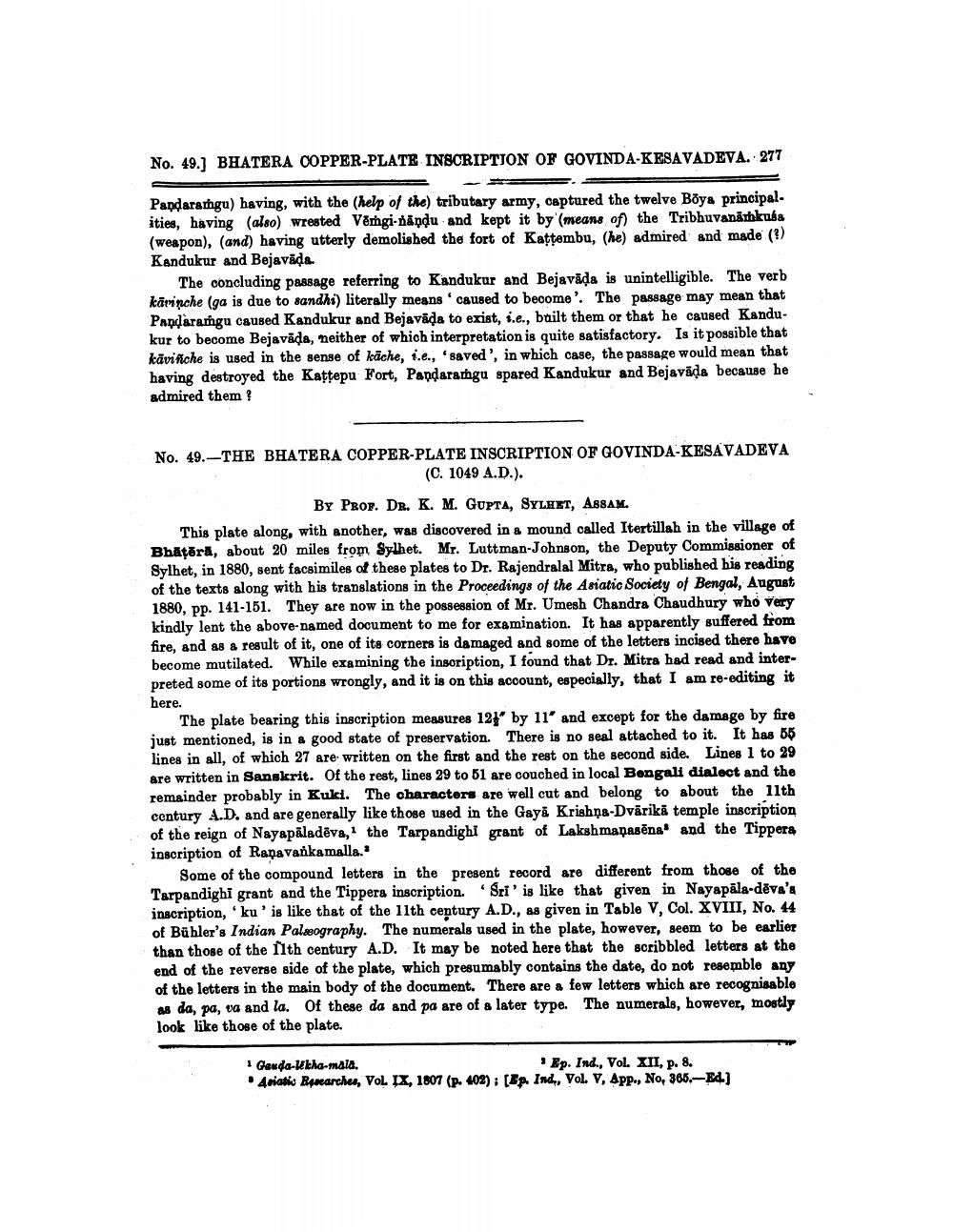________________
No. 49.) BHATERA COPPER-PLATE INSCRIPTION OF GOVINDA-KESAVADEVA. 277
Pandaragu) having, with the help of the) tributary army, captured the twelve Böys principal. ities, having (also) wrested Vēmgi-nându and kept it by means of the Tribhuvanāmkusa (weapon), (and) having utterly demolished the fort of Kattembu, (he) admired and made (?) Kandukur and Bejavāda.
The concluding passage referring to Kandukur and Bejavida is unintelligible. The verb kärinche (ga is due to sandhi) literally means caused to become'. The passage may mean that Pandaraṁgu caused Kandukur and Bejavāda to exist, i.e., built them or that he caused Kandukur to become Bejavāda, neither of which interpretation is quite satisfactory. Is it possible that kävifche is used in the sense of käche, i.e., saved', in which case, the passage would mean that having destroyed the Kattepu Fort, Pandaramgu spared Kandukur and Bejaväda because he admired them?
No. 49.-THE BHATERA COPPER-PLATE INSCRIPTION OF GOVINDA-KESAVADEVA
(C. 1049 A.D.).
BY PROF. DR. K. M. GUPTA, SYLHET, Assam. This plate along, with another, was discovered in a mound called Itertillah in the village of Bhäțără, about 20 miles from Sylhet. Mr. Luttman-Johnson, the Deputy Commissioner of Sylhet, in 1880, sent facsimiles of these plates to Dr. Rajendralal Mitra, who published his reading of the texts along with his translations in the Proceedings of the Asiatic Society of Bengal, August 1880, pp. 141-151. They are now in the possession of Mr. Umesh Chandra Chaudhury who very kindly lent the above-named document to me for examination. It has apparently suffered from fire, and as a result of it, one of its corners is damaged and some of the letters incised there have become mutilated. While examining the insoription, I found that Dr. Mitra had read and interpreted some of its portions wrongly, and it is on this account, especially, that I am re-editing it
here.
The plate bearing this inscription measures 121 by 11' and except for the damage by fire just mentioned, is in a good state of preservation. There is no seal attached to it. It has 56 lines in all, of which 27 are written on the first and the rest on the second side. Lines 1 to 29 are written in Sanskrit. Of the rest, lines 29 to 51 are couched in local Bengali dialect and the remainder probably in Kuki. The characters are well cut and belong to about the 11th century A.D, and are generally like those used in the Gaya Krishna-Dvärikā temple inscription of the reign of Nayapāladēva,' the Tarpandighi grant of Lakshmaņasēna and the Tippers inscription of Ranavankamalla."
Some of the compound letters in the present record are different from those of the Tarpandighi grant and the Tippera inscription. Sri' is like that given in Nayapāla dēva's inscription, ku' is like that of the 19th century A.D., as given in Table V, Col. XVIII, No. 44 of Bühler's Indian Palxography. The numerals used in the plate, however, seem to be earlier than those of the flth century A.D. It may be noted here that the scribbled letters at the end of the reverse side of the plate, which presumably contains the date, do not resemble any of the letters in the main body of the document. There are a few letters which are recognisable as da, pa, va and la. Of these da and pa are of a later type. The numerals, however, mostly look like those of the plate.
Ganda-tha-mala.
Ep. Ind., Vol. XII, p. 8. 4riatic Rearche, VoL IX, 1807 (P. 402); Cap. Ind., Vol. V, App., No. 366.-Ed.)




